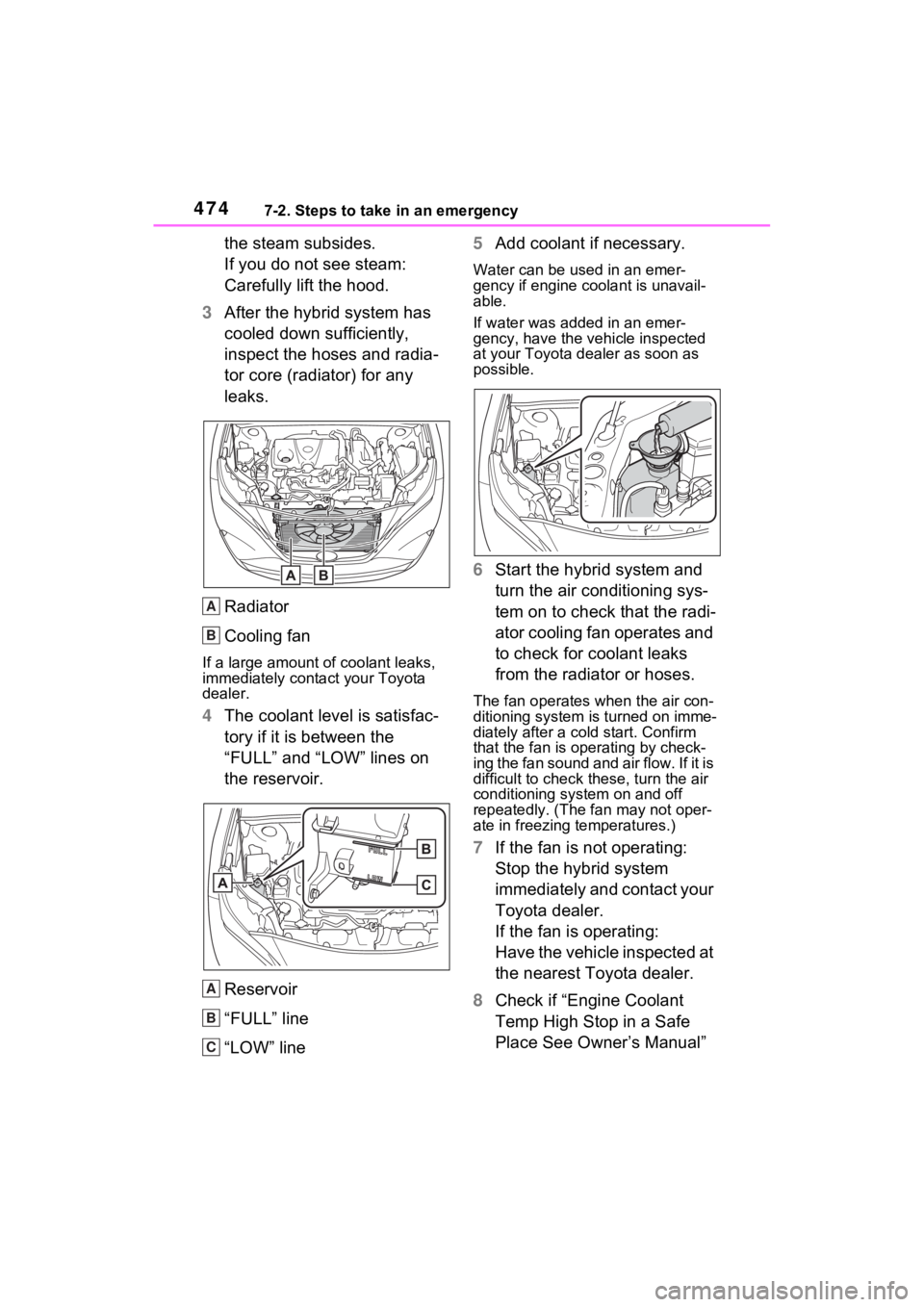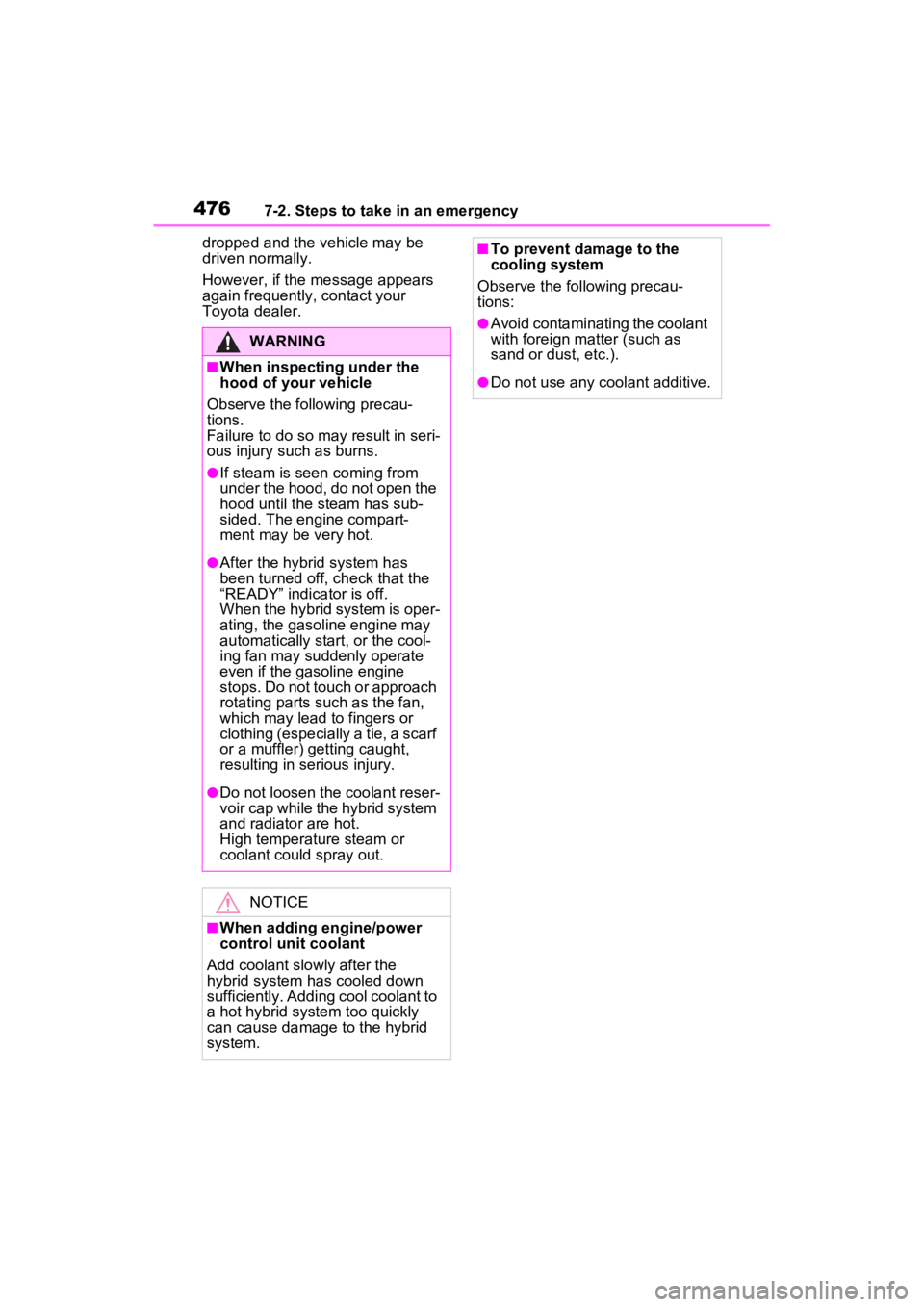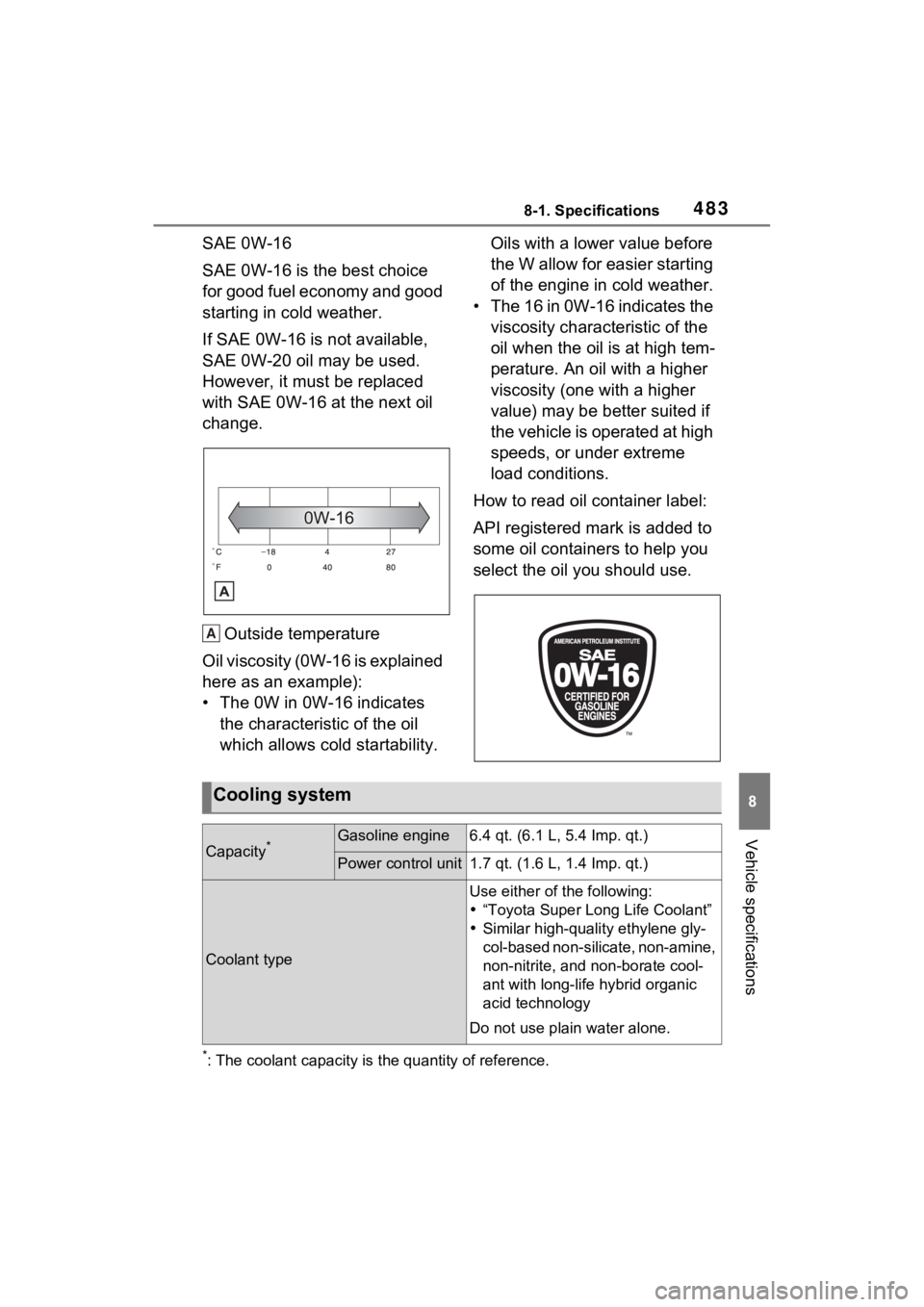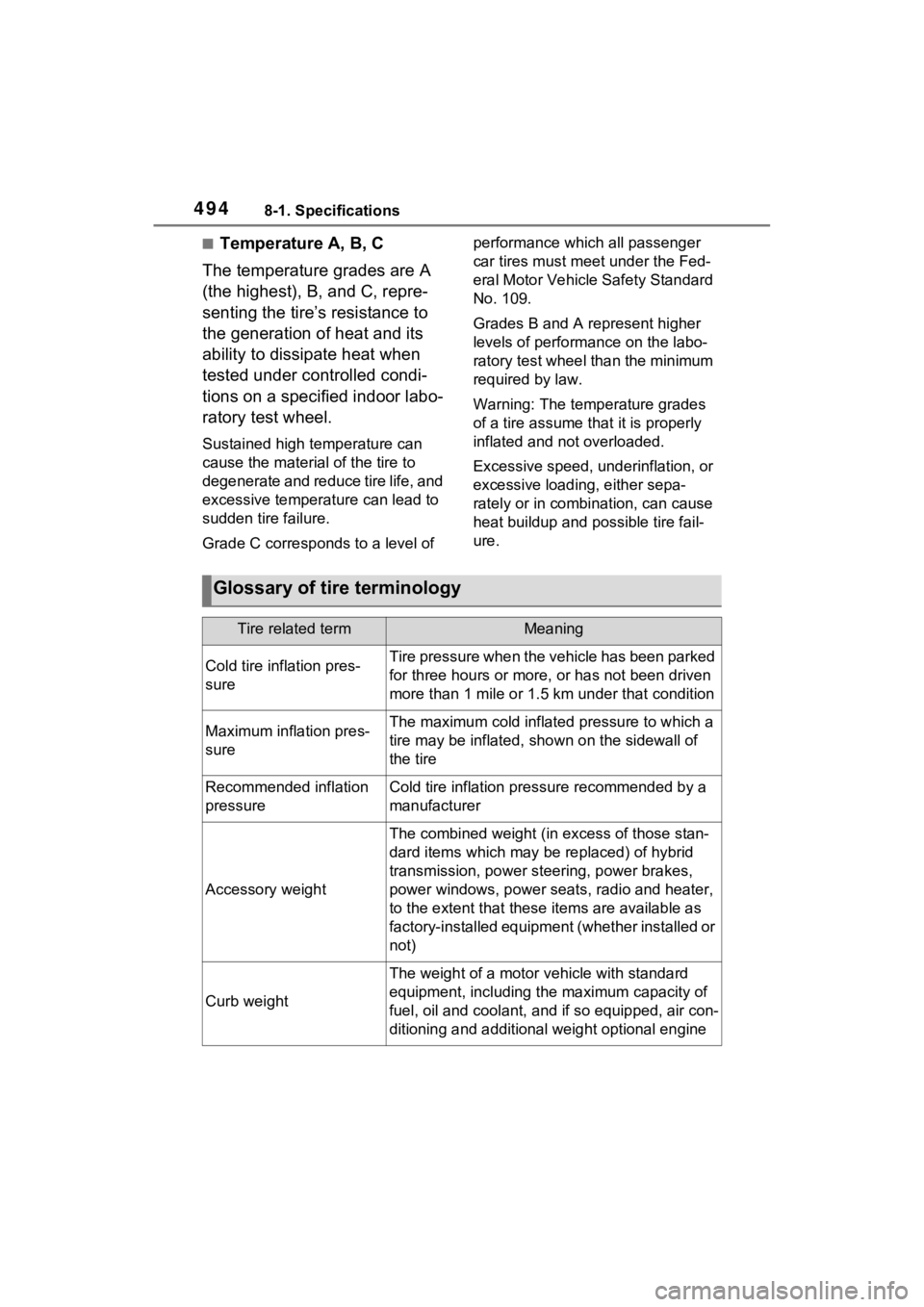2023 TOYOTA VENZA HYBRID engine coolant
[x] Cancel search: engine coolantPage 474 of 560

4747-2. Steps to take in an emergency
the steam subsides.
If you do not see steam:
Carefully lift the hood.
3 After the hybrid system has
cooled down sufficiently,
inspect the hoses and radia-
tor core (radiator) for any
leaks.
Radiator
Cooling fan
If a large amount of coolant leaks,
immediately contact your Toyota
dealer.
4The coolant level is satisfac-
tory if it is between the
“FULL” and “LOW” lines on
the reservoir.
Reservoir
“FULL” line
“LOW” line 5
Add coolant if necessary.
Water can be used in an emer-
gency if engine coolant is unavail-
able.
If water was added in an emer-
gency, have the vehicle inspected
at your Toyota dealer as soon as
possible.
6Start the hybrid system and
turn the air conditioning sys-
tem on to check that the radi-
ator cooling fan operates and
to check for coolant leaks
from the radiator or hoses.
The fan operates when the air con-
ditioning system is turned on imme-
diately after a cold start. Confirm
that the fan is operating by check-
ing the fan sound and air flow. If it is
difficult to check th ese, turn the air
conditioning system on and off
repeatedly. (The fa n may not oper-
ate in freezing temperatures.)
7 If the fan is not operating:
Stop the hybrid system
immediately and contact your
Toyota dealer.
If the fan is operating:
Have the vehicle inspected at
the nearest Toyota dealer.
8 Check if “Engine Coolant
Temp High Stop in a Safe
Place See Owner’s Manual”
A
B
A
B
C
Page 476 of 560

4767-2. Steps to take in an emergency
dropped and the vehicle may be
driven normally.
However, if the message appears
again frequently, contact your
Toyota dealer.
WARNING
■When inspecting under the
hood of your vehicle
Observe the following precau-
tions.
Failure to do so may result in seri-
ous injury such as burns.
●If steam is seen coming from
under the hood, do not open the
hood until the steam has sub-
sided. The engine compart-
ment may be very hot.
●After the hybrid system has
been turned off, check that the
“READY” indicator is off.
When the hybrid system is oper-
ating, the gasoline engine may
automatically start, or the cool-
ing fan may suddenly operate
even if the gasoline engine
stops. Do not touch or approach
rotating parts such as the fan,
which may lead to fingers or
clothing (especially a tie, a scarf
or a muffler) getting caught,
resulting in serious injury.
●Do not loosen the coolant reser-
voir cap while the hybrid system
and radiator are hot.
High temperature steam or
coolant could spray out.
NOTICE
■When adding engine/power
control unit coolant
Add coolant slowly after the
hybrid system has cooled down
sufficiently. Adding cool coolant to
a hot hybrid system too quickly
can cause damage to the hybrid
system.
■To prevent damage to the
cooling system
Observe the following precau-
tions:
●Avoid contaminating the coolant
with foreign matter (such as
sand or dust, etc.).
●Do not use any coolant additive.
Page 483 of 560

4838-1. Specifications
8
Vehicle specifications
SAE 0W-16
SAE 0W-16 is the best choice
for good fuel economy and good
starting in cold weather.
If SAE 0W-16 is not available,
SAE 0W-20 oil may be used.
However, it must be replaced
with SAE 0W-16 at the next oil
change.Outside temperature
Oil viscosity (0W-16 is explained
here as an example):
• The 0W in 0W-16 indicates the characteristic of the oil
which allows cold startability. Oils with a lower value before
the W allow for easier starting
of the engine in cold weather.
• The 16 in 0W-16 indicates the viscosity characteristic of the
oil when the oil is at high tem-
perature. An oil with a higher
viscosity (one with a higher
value) may be better suited if
the vehicle is operated at high
speeds, or under extreme
load conditions.
How to read oil container label:
API registered mark is added to
some oil containers to help you
select the oil you should use.
*: The coolant capacity is the quantity of reference.
A
Cooling system
Capacity*Gasoline engine6.4 qt. (6.1 L, 5.4 Imp. qt.)
Power control unit1.7 qt. (1.6 L, 1.4 Imp. qt.)
Coolant type
Use either of the following:
“Toyota Super Long Life Coolant”
Similar high-quality ethylene gly-
col-based non-silicate, non-amine,
non-nitrite, and non-borate cool-
ant with long-life hybrid organic
acid technology
Do not use plain water alone.
Page 494 of 560

4948-1. Specifications
■Temperature A, B, C
The temperature grades are A
(the highest), B, and C, repre-
senting the tire’s resistance to
the generation of heat and its
ability to dissipate heat when
tested under controlled condi-
tions on a specified indoor labo-
ratory test wheel.
Sustained high temperature can
cause the material of the tire to
degenerate and reduce tire life, and
excessive temperature can lead to
sudden tire failure.
Grade C corresponds to a level of performance which all passenger
car tires must meet under the Fed-
eral Motor Vehicle Safety Standard
No. 109.
Grades B and A represent higher
levels of performance on the labo-
ratory test wheel than the minimum
required by law.
Warning: The temperature grades
of a tire assume tha
t it is properly
inflated and not overloaded.
Excessive speed, underinflation, or
excessive loading, either sepa-
rately or in combination, can cause
heat buildup and possible tire fail-
ure.
Glossary of tire terminology
Tire related termMeaning
Cold tire inflation pres-
sureTire pressure when the vehicle has been parked
for three hours or more, or has not been driven
more than 1 mile or 1.5 km under that condition
Maximum inflation pres-
sureThe maximum cold inflated pressure to which a
tire may be inflated, shown on the sidewall of
the tire
Recommended inflation
pressureCold tire inflation pressure recommended by a
manufacturer
Accessory weight
The combined weight (in excess of those stan-
dard items which may be replaced) of hybrid
transmission, power steering, power brakes,
power windows, power seats, radio and heater,
to the extent that these items are available as
factory-installed equipment (whether installed or
not)
Curb weight
The weight of a motor vehicle with standard
equipment, including th e maximum capacity of
fuel, oil and coolant, and if so equipped, air con-
ditioning and additional weight optional engine
Page 536 of 560

536Alphabetical Index
Driving support system informa-tion display ................... 105, 116
Dynamic radar cruise control with full-speed rangeFunction ............................... 265
Warning message ................ 451
E
ECB (Electronically Controlled Brake System) ...................... 305
Eco drive mode ...................... 304
EDR (Event data recorder)......... 8
E-Four (Electronic On-Demand AWD system) ........................ 306
Elapsed time ........................... 104
Electric motor Location.................................. 70
Specification ......................... 482
Electric Power Steering (EPS) Function ............................... 306
Warning light ........................ 443
Electronically Controlled Brake System (ECB) ....................... 305
Electronic key Battery-saving function......... 155
If the electronic key does not operate properly ................. 466
Replacing the battery ........... 424
Electronic sunshade .............. 350 Operation ............................. 350
Emergency, in case of If a warning buzzer sounds .. 441
If a warning light turns on ..... 441
If a warning message is dis-played................................. 451
If the 12-volt battery is dis- charged .............................. 468
If the electronic key does not operate properly ................. 466
If the fuel filler door cannot be opened ............................... 465
If the hybrid sy stem will not start ...........................................463
If the vehicle is submerged or water on the road is rising ..434
If you have a flat tire .............456
If you lose your keys.............465
If you think something is wrong ...........................................439
If your vehicle becomes stuck ...........................................477
If your vehicle has to be stopped in an emergency .................433
If your vehicle needs to be towed ...........................................436
If your vehicle ove rheats ......473
Emergency flashers ...............432
Energy monitor .......................128
Engine Compartment........................390
Hood .....................................387
Identification number ............481
Engine coolant Capacity ...............................483
Checking ..............................393
Preparing and checking before winter ..................................313
Warning light ........................442
Engine coolant temperature gauge .......................................90
Engine oil Capacity ...............................482
Checking ..............................390
Preparing and checking before winter ..................................313
Warning light ........................442
Engine oil maintenance data .92, 392
Enhanced Vehicle Stability Con- trol (Enhanced VSC ) .............306
Enhanced VSC (Enhanced Vehi- cle Stability Control).............306
EPS (Electric Po wer Steering)
Function................................306
Page 545 of 560

Alphabetical Index545
Turn signal lever................... 212
U
USB Type-C charging ports .. 354
Utility vehicle precautions ..... 316
V
Vanity lightsVanity lights .......................... 353
Vanity mirrors ......................... 353
Vehicle data recordings ............. 7
Vehicle identification number480
Vehicle Stability Control (VSC) ............................................... 306
Ventilators (seat ventilators) . 337
VSC (Vehicle Stability Control) ............................................... 306
W
Warning buzzers Approach warning ................ 272
Brake hold ............................ 446
Brake Override System ........ 445
Brake system ....................... 441
Downshifting......................... 211
Drive-Start Control ............... 445
Electric power steering ......... 443
High coolant temperature ..... 442
Intuitive parking assist OFF indi-cator ................................... 444
Intuitive parking assist .......... 287
Low engine oil pressure ....... 442
LTA (Lane Tracing Assist).... 250
LTA indicator ........................ 444
Open door ............................ 140
Open hood ........................... 140
PKSB OFF indicato r ............. 444
PKSB.................................... 445
Pre-collision warning ............ 239
RCTA (Rear Cross Traffic Alert) ...........................................278
RCTA OFF indicator .............445
Seat belt reminder ................447
Vehicle sway warning ...........255
Warning lights ABS ......................................443
Brake hold operated indicator...........................................446
Brake Override System ........445
Brake system ........................441
Charging system ..................441
Drive-Start Control ................445
Electric power steering .........443
Engine ..................................442
High coolant temperature .....442
Intuitive parking assist OFF indi- cator ...................................444
Low engine oil pressure .......442
Low fuel level........................446
LTA indicator ........................444
Malfunction indica tor lamp ....442
Parking brake indicator.........446
PCS warning light .................443
PKSB (Parking Support Brake) ...........................................445
PKSB OFF indicator .............444
RCTA OFF indicator .............445
Seat belt reminder light ........447
Slip indicator .........................445
SRS ......................................442
Tire pressure ...... ..................446
Warning messages .................451
Washer Checking ..............................396
Low washer fluid warning mes-sage............................396, 451
Preparing and checking before winter ..................................313
Switch ...........................226, 229
Washing and waxing ..............372
Weight Cargo capacity .............195, 198